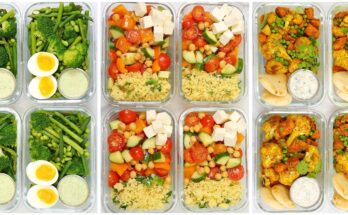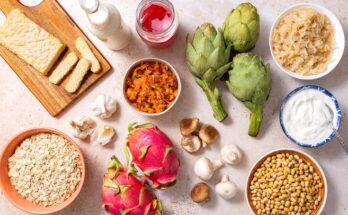Grape Leaves Recipe: If you’ve ever tasted the soft, flavorful bites of stuffed grape leaves, you know they’re more than just a dish – they’re an experience. Known as dolma or warak enab, these little green parcels are a staple in Mediterranean and Middle Eastern kitchens. But here’s the best part – you don’t need to be a chef to master them. Whether you’re making them for the first time or you’re brushing up your skills, this step-by-step guide will walk you through everything you need to know.
Introduction to Grape Leaves
A Mediterranean Delight
Stuffed grape leaves, often referred to as dolmas or warak enab depending on the region, have been a favorite dish for generations. Rooted in the culinary traditions of Greece, Turkey, Lebanon, Egypt, and other Mediterranean and Middle Eastern countries, this dish combines simplicity with sophistication.
The leaves themselves are tender, slightly tangy, and full of character. When filled with rice, herbs, and sometimes meat, and then cooked gently until they absorb all the flavorful goodness – you get one of the most satisfying appetizers or snacks around. They’re usually served cold or at room temperature, often with a side of creamy tzatziki or tangy yogurt.
These grape leaves are more than just food. They’re about heritage, family, and sharing meals together.
Cultural Significance and Variations
Different cultures put their own spin on stuffed grape leaves. In Greece, dolmades are typically vegetarian and served with a lemony sauce. In Lebanon and Syria, warak enab might be filled with ground lamb or beef alongside rice, tomatoes, and spices. In Armenia, they’re made with unique regional herbs.
This diversity is what makes grape leaves such an exciting dish to cook and customize. No two families make them the same way, and everyone swears their version is the best. (And honestly, they’re probably right.)
List of Ingredients You’ll Need
Before diving into the actual cooking, let’s go over the ingredients. You might already have most of them in your pantry!
Grape Leaves (Fresh vs. Jarred)
The star of the dish, of course, is the grape leaf. You can usually find jarred grape leaves in brine at Middle Eastern or Mediterranean markets – or even online. They’re already tenderized and preserved, but they need a good rinse before using.
Fresh grape leaves are a seasonal treat. If you’re lucky enough to get them from a vine (or a local farmer’s market), blanch them in boiling water for a few minutes to soften them.
What to look for:
- Medium-sized leaves
- No holes or tears
- Tender, not tough or fibrous
Rice – The Filling Base
Rice is the main filler in most dolma recipes. Choose short or medium-grain rice like:
- Arborio (ideal for its creamy texture)
- Egyptian rice
- Calrose rice
Avoid long-grain rice as it tends to be too firm and separate.
Optional twist: Mix in a little bulgur for extra texture.
Aromatics and Fresh Herbs
This is where the flavor magic happens. You’ll need:
- Onions – finely chopped
- Garlic – minced
- Fresh parsley
- Dill
- Mint (fresh or dried)
These herbs give the filling a bright, fresh taste that balances out the rich olive oil and spices.
Spices and Seasonings
Don’t skip the seasoning. It brings everything together:
- Salt and pepper
- Cinnamon (optional but adds warmth)
- Allspice
- Paprika
- Lemon juice (for brightness)
Olive oil is a must – not just in the filling, but also for cooking the rolls.
Optional Add-ins (Meat, Nuts, etc.)
You can stick to a vegetarian version, or go heartier with additions like:
- Ground beef or lamb
- Pine nuts or walnuts
- Currants or raisins (for a sweet contrast)
These extras turn dolmas into a full-blown entrée rather than just a side dish.
Preparation Tips Before You Start
How to Prepare Grape Leaves Properly
If you’re using jarred grape leaves, remove them from the brine and soak them in warm water for 10–15 minutes. Rinse thoroughly to get rid of excess salt and preservatives.
For fresh grape leaves, blanch them:
- Boil water in a large pot.
- Submerge leaves for 2–3 minutes until soft and flexible.
- Transfer to a bowl of ice water to stop the cooking.
- Drain and pat dry with paper towels.
Pro tip: Stack leaves flat and trim the stems before filling.
Soaking Rice and Chopping Herbs
Soaking your rice for 15–20 minutes before cooking helps it soften and absorb flavors better during cooking. While the rice is soaking, start chopping your herbs, onions, and garlic finely.
- Use a sharp knife – no one likes chunky onions in their dolmas.
- A food processor can make the chopping process quicker, but don’t overdo it. You want texture, not mush.
Step-by-Step Guide to Making Grape Leaves
Let’s get cooking. Now that everything is prepped, here’s how to bring it all together.
Step 1 – Rinse and Blanch Grape Leaves
As discussed earlier, whether fresh or jarred, this step is essential to ensure your grape leaves are soft and pliable. No one wants to bite into a tough roll.
- Rinse the leaves under cool water.
- Blanch if needed.
- Lay them out on paper towels or a clean dish towel, shiny side down – the dull side will face up (and that’s the one you fill).
Step 2 – Prepare the Filling
In a large mixing bowl, combine:
- Soaked and drained rice
- Finely chopped onions and garlic
- Fresh parsley, mint, and dill
- Olive oil
- Lemon juice
- Salt, pepper, and spices
If you’re adding meat or nuts, mix them in now.
Mix well but gently – you don’t want to mash the rice.
Step 3 – Roll the Grape Leaves
Here comes the fun (and slightly tricky) part – rolling the leaves. Once you get the hang of it, it’s actually pretty relaxing, like culinary origami.
Here’s how to roll them perfectly:
- Lay the leaf flat on a clean surface, vein side up (shiny side down).
- Add 1–2 teaspoons of filling near the stem end of the leaf.
- Fold the bottom up over the filling.
- Fold the sides inward, like you’re making a burrito.
- Roll tightly but gently all the way to the top.
The key is to roll them firm enough that they hold their shape while cooking, but not too tight – the rice needs room to expand.
Place each roll seam-side down in your pot so they don’t unravel during cooking.
Tip: If your grape leaves tear, don’t panic. You can patch small holes with pieces of another leaf or double-wrap them.
Step 4 – Layer and Cook the Dolmas
Once you’ve rolled all your grape leaves, it’s time to cook them to perfection. This is where they soak up all that savory, lemony, olive-oil goodness.
Here’s how to cook them right:
- Line the bottom of a large pot with a layer of unused or torn grape leaves. This prevents sticking and adds flavor.
- Place the rolls in snug layers, seam-side down. You can stack them if needed.
- Add a few lemon slices between the layers for added flavor.
- Drizzle with olive oil, then pour in enough water (or a mix of water and broth) to just cover the top layer.
- Place a heat-safe plate or small lid on top of the dolmas to keep them from floating or unraveling.
- Bring to a simmer, cover the pot, and cook on low heat for about 45–60 minutes.
You’ll know they’re done when the rice is tender and the grape leaves are silky soft.
Step 5 – Let Them Rest and Serve
Once the cooking is done, don’t serve them right away – let the dolmas rest in the pot for at least 30 minutes with the lid on. This allows all the flavors to settle and the grape leaves to firm up a bit for better texture.
After they’ve rested, carefully remove them using tongs or a slotted spoon and transfer to a serving plate.
Drizzle with a bit more olive oil, squeeze over fresh lemon juice, and garnish with chopped parsley if you’re feeling fancy.
You can serve them warm, room temperature, or cold – they’re delicious every way. Many prefer them chilled as an appetizer or mezze dish, paired with yogurt or a garlicky dip.
Tips for the Perfect Grape Leaves
Don’t Overfill or Overcook
This is where many first-timers go wrong. Overstuffed dolmas tend to burst open while cooking, and nobody wants that mess.
- Stick to 1–2 teaspoons of filling per leaf – you’re not making burritos.
- Leave room for the rice to expand during cooking.
- Don’t overcook – 45–60 minutes is plenty. Overcooking can make them mushy or fall apart.
Flavor-Boosting Tricks
Want your dolmas to have that restaurant-quality taste? Try these:
- Add broth instead of plain water for cooking – vegetable, chicken, or beef.
- Infuse with lemon zest or bay leaves.
- Layer with sliced garlic and tomatoes for extra aroma and richness.
- A splash of pomegranate molasses gives a subtle sweetness and depth, especially in Middle Eastern-style warak enab.
Also, don’t skimp on olive oil – it’s a big part of what makes these taste luxurious and moist.
Serving Suggestions
What to Serve with Grape Leaves
Stuffed grape leaves shine on their own, but they’re even better as part of a Mediterranean spread. Here are a few pairings that elevate your meal:
- Greek or Lebanese Salad – crisp cucumbers, tomatoes, olives, and feta
- Grilled Meats – lamb skewers, chicken shawarma, or kofta
- Falafel or Hummus – for a full plant-based mezze experience
- Fresh Pita Bread – perfect for scooping up sauces
- Pickled vegetables – add a tangy crunch to the table
They also work great on party platters or as a side dish during holiday dinners.
Best Dips and Sides
These dips complement the grape leaves beautifully:
- Tzatziki – cool and creamy yogurt cucumber sauce
- Labneh – tangy, thick yogurt cheese topped with olive oil
- Tahini sauce – sesame-based and slightly nutty
- Garlic yogurt dip – simply mix yogurt with minced garlic and salt
Add a drizzle of olive oil and a sprinkle of sumac or paprika to your dip bowls for extra flair.
Storage and Reheating Instructions
How to Store Leftovers
Dolmas store very well, making them ideal for meal prep or leftovers.
Here’s how to store them:
- Let them cool completely.
- Place in an airtight container.
- Add a thin layer of olive oil or lemon juice to keep them moist.
- Refrigerate for up to 5 days.
They even taste better the next day as the flavors continue to meld.
Reheating Without Losing Flavor
You can enjoy grape leaves cold, but if you prefer them warm:
Stovetop Method:
- Place them in a pot with a splash of water or broth.
- Cover and warm over low heat until heated through.
Microwave Method:
- Place a few dolmas on a plate.
- Cover with a damp paper towel.
- Microwave in 30-second bursts until warm.
Avoid overheating, or they’ll dry out and lose their lovely texture.
Common Mistakes to Avoid
Overcooked Rice or Tough Leaves
Let’s be honest – not every grape leaf recipe turns out Instagram-worthy the first time. But if you avoid these common mistakes, your dolmas will look and taste like they came straight from a Mediterranean grandma’s kitchen.
Mistake #1: Overcooking the rice.
Rice that’s too soft becomes mushy and ruins the texture of the filling. Soaking rice beforehand is key, but don’t parboil or pre-cook it. The rice will cook perfectly inside the grape leaves during simmering.
Mistake #2: Using tough grape leaves.
If your leaves are too thick or old, no amount of cooking will soften them. Always choose tender leaves, and blanch fresh ones until just pliable. If you’re using jarred grape leaves, rinse and soak them well to reduce the briny flavor and soften them up.
Loose Wrapping Issues
If your grape leaves are falling apart during cooking, it usually comes down to loose rolling or not layering them tightly enough in the pot.
How to fix it:
- Always roll tightly but not so tight that the rice has no room to expand.
- Place them seam-side down in the pot.
- Weigh them down with a plate or lid while cooking to keep them from unraveling.
Another mistake? Skipping the bottom layer of grape leaves in the pot. This step is vital. It protects the dolmas from sticking and burning.
Health Benefits of Grape Leaves
Nutritional Breakdown
Grape leaves might be small, but they pack a punch when it comes to nutrition. Here’s why these little rolls are actually pretty good for you:
- Low in calories – about 14 calories per leaf
- Rich in fiber – helps digestion and keeps you full longer
- High in vitamin A – supports eye health
- Good source of vitamin K – important for bone health
- Antioxidants – grape leaves contain flavonoids, which fight inflammation
Pair that with a filling made from rice, olive oil, and herbs – and you’ve got a wholesome, plant-powered dish that nourishes your body and satisfies your taste buds.
Why They’re a Heart-Healthy Snack
Thanks to the olive oil, herbs, and rice (especially when brown rice is used), grape leaves are aligned with the Mediterranean diet – one of the most heart-healthy ways of eating on the planet.
Some health bonuses:
- Olive oil helps lower “bad” cholesterol.
- Fresh herbs like dill, mint, and parsley are anti-inflammatory.
- Vegetarian dolmas are naturally free of cholesterol and low in saturated fat.
Want an even healthier version? Skip the meat and use whole grain rice, quinoa, or bulgur for a fiber-rich filling.
Variations Around the World
Greek Dolmades vs. Lebanese Warak Enab
Different countries, different names, same delicious concept. But what sets these variations apart?
Greek Dolmades:
- Typically vegetarian
- Often flavored with dill, mint, and lemon
- Served cold with avgolemono (egg-lemon) sauce
- Rolled tighter and shorter
- Commonly eaten as a meze (appetizer)
Lebanese Warak Enab:
- Often include ground lamb or beef
- More spices like cinnamon and allspice
- Cooked with tomatoes, garlic, and sometimes pomegranate molasses
- Served warm or room temp
- Often paired with laban (yogurt) on the side
Other regional styles:
- Turkish dolma might include pine nuts and raisins.
- Egyptian mahshi is bulkier and usually served hot.
- Armenian versions often include tart flavors like sumac or dried apricots.
Vegetarian vs. Meat-Filled Styles
This dish is super flexible. Whether you’re feeding vegans or meat-lovers, there’s a grape leaf variation for everyone.
Vegetarian dolmas:
- Packed with rice, onion, herbs, lemon juice, olive oil
- Best served cold or room temperature
- Great as a snack or appetizer
Meat-filled dolmas:
- Include ground beef, lamb, or even turkey
- Hearty and satisfying – a full meal
- Best served warm, sometimes with tomato or yogurt sauce
You can even mix half-meat and half-veggie batches to keep everyone happy!
Grape Leaves for Special Occasions
Perfect for Parties and Festive Feasts
Stuffed grape leaves aren’t just everyday eats – they’re showstoppers on special occasions. In many Middle Eastern, Balkan, and Mediterranean cultures, dolmas are a must-have at weddings, religious celebrations, and family gatherings.
Why they’re perfect for events:
- They can be made ahead of time – saving you stress on the day
- They’re easy to serve cold or room temp
- They look beautiful when arranged in spiral patterns or stacked on platters
- They’re hand-held, which makes them ideal for buffets and mezze spreads
Some hosts even add decorative touches:
- Topping each roll with a pine nut or pomegranate seed
- Serving them in grape leaf-lined baskets
- Pairing them with mini signs for each variation (vegan, meat, spicy, etc.)
You can also make a large batch in advance, freeze some, and have a go-to party appetizer ready anytime.
FAQs about Grape Leaves Recipe
1. Can I freeze grape leaves?
Yes, both fresh and cooked grape leaves can be frozen. If freezing fresh ones, blanch and dry them first. For cooked dolmas, cool them completely, then store in an airtight container with a little olive oil. Freeze for up to 3 months.
2. What kind of rice should I use?
Short to medium-grain rice like Calrose or Arborio works best. Avoid long-grain rice, as it doesn’t hold together well and may result in loose or dry filling.
3. Can I make these ahead of time?
Absolutely. In fact, they taste better the next day. Make them 1–2 days ahead, refrigerate in an airtight container, and serve chilled or reheat if desired.
4. Are grape leaves keto-friendly?
The leaves themselves are low in carbs, but traditional dolmas with rice are not keto-friendly. You can make a keto version by using cauliflower rice or a ground meat and vegetable filling.
5. What’s the difference between dolma and sarma?
“Dolma” generally refers to “stuffed” vegetables, including grape leaves, peppers, and zucchini. “Sarma” is a Turkish word meaning “wrapped,” and usually refers to grape or cabbage leaves rolled around a filling.
Conclusion
Stuffed grape leaves may seem like an intricate dish, but once you break it down step by step, it’s all about preparation and patience. From choosing the right leaves to mastering the roll, this dish rewards you with bold flavor, beautiful presentation, and cultural richness in every bite.
Whether you’re going for a vegetarian version bursting with herbs or a meaty variation with warm spices, dolmas are a culinary love letter from the Mediterranean and Middle East straight to your kitchen.
So go ahead—gather your ingredients, roll up your sleeves, and roll your way into the world of homemade grape leaves. You won’t regret it.



